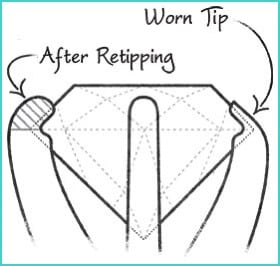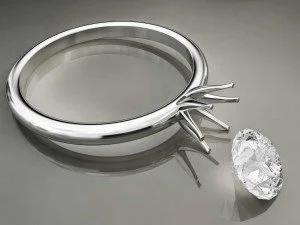Almost three years ago, I wrote about how jewellery, and especially engagement rings are not indestructible. The fact remains that if you buy a piece of jewellery, and you wear it on a regular basis, at some point, whether it be in a year’s time or 50 years’ time, your will need to get it repaired or resized. That said, getting your jewellery repaired, resized or re-modelled can sometimes be a minefield, so below I’ll discuss five of the most common mistakes people make when getting their jewellery repaired.
Paying Too Much or for Unnecessary Repairs
Every so often, a client contacts us, usually for a resize, having taken their ring to another jeweller who has proceeded to quote some astronomical price for a simple resize. In one case, a customer in Melbourne had been quoted $400 for a simple resize of a platinum solitaire ring. Because we made the ring, we were able to resize it for a more reasonable $40. However, before you cry blue murder, there may be some legitimate reasons some jewellers quote and charge so much for repairs, such as:
• The jeweller is busy with other jobs, and another repair job will simply take time away from the profitable jobs that they are currently working on. In this instance, the jeweller may overquote, or put simply, apply “piss off pricing”.
• The jeweller has large overheads that need to be serviced. Given the jewellery industry sells luxury products, overheads such as high rents and a large number of unproductive staff are common, and all add to the cost to the end consumer. What may be a $100 repair from a small independent repair shop may well end up costing over $1000 from a so-called “high end boutique”.
• The jeweller doesn’t have the necessary tools, knowledge, or suppliers to complete the job efficiently. For example, nowadays, laser welders are common and inexpensive and when they first came on the market were heralded as a “game changer” for the jewellery repair industry. If a jeweller doesn’t have a laser welder, the repair may take longer, hence cost more. Similarly, if a jeweller doesn’t have the right supplier for a particular part needed for a repair and has to make it themselves, this will add to the cost quite significantly.
• The jeweller is pricing in potential “booby traps”. For older jewellery, which may have been repaired multiple times before, the previous jeweller may not have done the repair correctly, or used the wrong solder, which may make the current repair job a lot harder. However, a competent jeweller should be able to be identify any “booby traps” prior to accepting the job.
• The jeweller has a general beef with you, the item of jewellery, or the company you bought it from. Unfortunately, the jewellery industry is filled with “colourful” characters, who most who are bench jewellers.

Above: Some jewellery repair quotes are really shocking.
Paying Too Little
On the opposite end of the scale, you may end up paying too little for your jewellery repair. If you wonder why resizing your wedding ring two sizes up only costs $20 when others were charging $100, then it is most likely the jeweller simply stretched it, rather than adding metal to it. Likewise, if you bring your grandmother’s ring to a jeweller to be resized, and the jeweller simply resizes it without checking the rest of the ring for broken or worn claws, you may end up paying more in the future for repairing and retipping the claws. A competent jeweller should take the time and explain clearly what your options are and the work and materials that are involved in the repair, so that you, as the client understand.

Above: A diagram showing worn claws that need re-tipping
Accepting Bad Repairs
Over the years, I have seen some pretty bad resize and repair jobs. From visible solder joins after a resize to chain links being soldered together (rather than being repaired). What’s worse is that the customers who have brought these items to me have all paid for these resizes or repairs, and then brought them the back to me to repair the repair! If I had done a resize or repair to that standard, I would be extremely embarrassed and would fix it straight away, so it baffles me as to how or why other jewellers can get away with doing bad repairs. That said, I think this situation is very rare, and most jewellers would remedy the situation, with their tail between their legs so to speak.
Signing Up for A “Care” or “Maintenance Plan”
Some jewellers offer a care plan which covers basic repairs and resizing for a set period of time. Whilst this may sound like a good idea, there are numerous problems with these plans, such as:
• Pricing is usually based on the item’s value, and not the likelihood of the item needing to be repaired. Therefore, one may argue that these plans are a mere “cash grab”, much like extended warranties are on consumer electronics.
• They are expensive, yet they are not a replacement for proper jewellery insurance.
• They have a Laurie Potter vibe to them – that is, your pay a large sum upfront, but if the company goes broke, your plan is worthless. For those not in Perth in the 1980s, Laurie Potter started a chain of gyms whereby you would pay a one off membership for life. Needless to say, the chain collapsed in the mid-1980s.
Not Getting Insurance
Whilst the vast majority of jewellery repairs are fairly minor and can be fixed quite easily and at a minimal cost, accidents can happen, and the last thing you want is for a large diamond to get lost of fall out of the setting. This is why I recommend taking out insurance, at least for the first year, as the first year is when accidents most commonly happen.

Above: The worst scenario is that you lose a large diamond without it being insured.
In conclusion, to avoid the hassle and cost, my recommendation is always to take it back to the jeweller who sold the piece to repair. However, if this is not available, it is best to take it to a jeweller who has transparent pricing, such as a price guide and who can properly inspect the piece to accurately give you a quote and explain clearly what work needs to be done.